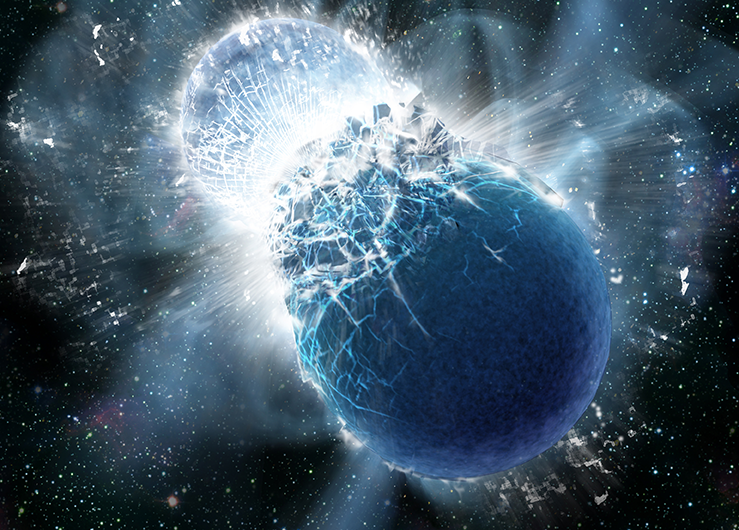At the origin of the binary systems of stars, a couple’s story
Pairs of massive stars are born and evolve through phases governed by mechanisms that are still poorly understood. By observing these stellar systems during specific phases of their evolution, it is possible to trace their history in order to understand where they come from, and thus better predict their future evolution. Two studies published in the journal Astronomy and Astrophysics by a team of researchers from the APC laboratory address these questions and explain the impact of various evolutionary mechanisms on binary systems, such as supernova explosions or their migration through the Milky Way.
Massive stars are born and evolve over short timescales, astrophysically speaking. In a few tens of millions of years, they end their life by collapsing on themselves, giving birth to a neutron star or a black hole. The physical mechanisms that govern the evolution of these massive stars are still poorly understood. Moreover, a large majority of massive stars spend at least part of their lives in pairs and can, if conditions permit, exchange matter during various phases of their evolution. Studying these binary systems is thus essential to better understand stellar evolution in general.
Among the evolutionary phases of a stellar pair, the so-called X-binary is particularly worth studying: this phase takes place after the explosion of a supernova, leaving in its place a neutron star with a radius of about ten kilometers only. This same star can then capture matter from the remaining companion, allowing it to emit large amounts of high energy photons – X-rays – hence the name X-binary.

Credits: Gabriel Pérez Díaz, SMM (Instituto de astrofísica de Canarias).
A team of researchers from the Astroparticle and Cosmology Laboratory (APC, Université Paris Cité / CNRS), in collaboration with researchers from the Argentine Institute of Radio Astronomy, proposes two studies, published in Astrophysics & Astronomy, reviewing the history of X-ray binaries observed in the Milky Way. These studies attempt to identify the birthplace of these X-binaries to know their exact age, and to understand how the supernova affects the relationship between the two stars. This supernova explosion can indeed propel the couple across the Galaxy at speeds otherwise unattainable: this is called the “natal kick”.

Credits: Francis Fortin, Laboratoire APC (Université Paris Cité / CNRS).
The contribution of Gaia satellite data to track down X-ray binaries
By measuring the velocity of X-ray binaries in the Milky Way, it is possible to answer these two questions. To do this, the researchers used data from Gaia, a satellite that has so far established a catalog of two billion stars, whose positions and velocities it has measured precisely – so-called astrometric measurements – including those of the X-binaries that interested them.
To answer the question of the impact of the supernova on the stellar pairs, the researchers used already existing equations that link the orbital parameters of a binary system before and after the supernova explosion. By combining these equations with a Bayesian statistical approach, the team was able to estimate the strength of the natal kick that initially propelled these systems to the speeds measured today by Gaia. They were thus able to quantify the impact of the supernova on 35 X-binaries in our Milky Way.
With these same astrometric measurements from Gaia, it is possible to trace the path taken by these systems through the Galaxy during the few million years of their life. By integrating their motion over time and comparing their trajectories with those of the galactic structures that host star formation, the researchers were able to determine the birthplace of these binary systems. This gives a measure of the age of the X-binaries (ranging from 2 to 40 million years in the sample studied), and even allows them to determine the initial masses of the two stars of which the pair is composed. If these masses are not surprising for massive stars, this study shows that the binary interaction can lead to a significant exchange of mass between the two stars, which can reach as much as two thirds of their initial mass.

Credits: Dana Berry/Skyworks Digital, Inc./The Kavli Foundation
These results on the impact of supernovas and on the birthplaces of massive X-ray binaries, provide valuable information on their history and can be used to calibrate models that predict the characteristics of the current population of binary systems. This will allow, amongst other things, to better understand their life up to the stage of compact binary: the two stars having collapsed, then collide and merge by releasing a puff of gravitational waves.
Publications:
· « Constraints to neutron-star kicks in high-mass X-ray binaries with Gaia EDR3 » ; Francis Fortin, Federico García, Sylvain Chaty, Eric Chassande-Mottin, Adolfo Simaz Bunzel ; A&A 665 A31 (2022).
· « Finding the birthplace of HMXBs in the Galaxy using Gaia EDR3: Kinematical age determination through orbit integration » ; F. Fortin, F. Garcia, S. Chaty ; A&A 665, A69 (2022).
The LabEx UnivEarthS contributed to this research by funding the Interface project “Binary rEvolution” (I10).
This article was first publishe on the IN2P3 website.
